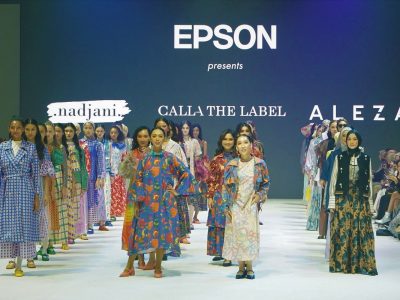Traditional Kyoto Textile Printing Embraces Digital
Textile studios in Kyoto have always embraced traditional printing methods. Two studios though recently added digital printing to their textile printing operations.
The ancient Japanese capital city of Kyoto has long been synonymous with impeccable design principles: a city dotted with golden temples, perfectly primmed gardens and handcrafted textiles.
Textile printing is huge business here. Recently, there has been a meeting of technology and tradition in the craft, with the latest evolution of textile printers, the Monna Lisa Evo, being adopted as the premier printer for Kyoto textile businesses.
Biken Textiles are renowned for the highest standard when it comes to textile craft. The Kyoto studio uses traditional analogue and state-of-the-art digital printing methods for its diverse range of textiles.

Fabric printed by Leaf
“High-quality ink colouring was the main motivation behind my choice. Epson ink is capable of almost-perfect natural colour reproduction, even with synthetic fibres like polyester,” says Hidehiro Hirakoshi, CEO.
One major issue for Biken designers to overcome in the past has been the exact colour profile for its intricate patterns to print on different materials: cotton, polyester and other synthetics.
However, Mr Hirakoshi says, “with the Monna Lisa’s ink we can achieve the same colouring regardless of the material.”

Fabric printed by Leaf
Meanwhile across Kyoto at Leaf, the studio has seen a change in the market over the past few years from mass production orders to more varied and smaller lots.
“Our decision to go with the Monna Lisa Evo was based on its global recognition as a printer capable of both high turnaround and design flexilbity in order to meet market trends and optimise sales figures,” says a Leaf spokesperson.
For Leaf, the team previously spent vast amounts of time making plates by hand for their textiles, but after adding the Monna Lisa Evo to their production line, plate-making is now a thing of the past, saving time and money.

The Monna Lisa textile printer by Epson
Jointly developed by Epson and Italy’s Robustelli, the Monna Lisa inkjet textile printer uses a type of staining technique to print designs onto fabrics. These fabrics are processed into items such as clothing, ties and scarfs by apparel makers, and are sold to customers.
Epson first entered the textile printing market back in 2003 when it jointly developed the technology with Robustelli, a leading Italian manufacturer of printing machines. They created The Monna Lisa, which was designed based on Epson’s proprietary Micro Piezo inkjet technology.
Posts You May Like
Get Social With Us



